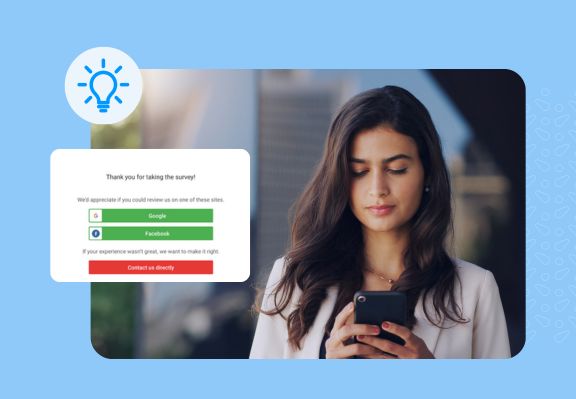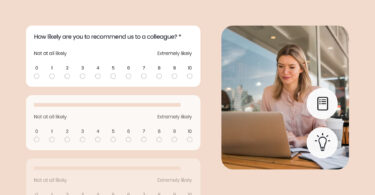The people who take part in your surveys are just as crucial as the accuracy of the survey results. Unfortunately, finding the right survey respondents can be challenging for many business owners.
If you’re on the hunt for customer opinions, you need to target the correct audience — one that will be fair but honest. And knowing where and how to find that audience is key.
From targeting website visitors to connecting with the right pool of people, in this blog, we’ll give you ideas on where you can find ideal survey respondents.
Table of contents
What are survey respondents?
Survey respondents are participants who share their experiences and opinions while answering survey questions. It could be someone who has gone through the whole customer journey or individuals who have previous experience with your business.
Why do businesses need survey respondents?
Businesses need survey respondents to obtain relevant customer feedback, opinions, and experiences to improve customer satisfaction. Finding qualified and willing survey participants allows for a high response rate.
How to choose the right survey respondents
Selecting the right survey respondents allows you to obtain relevant, accurate, and actionable customer feedback.
You want to distribute your survey to respondents who:
- Are relevant to the questions you are asking
- Have been through the entire customer journey with your brand
- Have recent experience with your brand, especially if you’re asking questions about products/services
Here’s how to choose the right survey takers who will provide quality responses to your questions.
- Define your objectives: Clearly identify the objectives of your survey. Be straightforward with the questions so respondents understand what you’re asking.
- Identify your target audience: Identify the broad group of people you want to reach with your survey. This is your target audience. Take into account their demographics, behaviors, sales history, and other relevant data.
- Determine your sample size: The sample size is the number of people you need to survey to draw the best conclusions. Use statistical tools and formulas to calculate an ideal sample size based on your desired confidence level and margin of error.
- Segment your audience: If your survey has multiple objectives or if your target pool of people is diverse, consider segmenting your audience. This allows for comparisons between different groups.
- Ask screening questions: Screening questions help you gather feedback from respondents who fit your target profile. For example, if you’re interested in opinions from people who have bought a specific product, start with survey questions that filter out those who haven’t.
- Offer incentives: Giving participants a discount or other rewards can boost response rates. Ensure incentives are relevant and manageable as to bias responses.

Types of survey respondents to beware of
When conducting a survey, you want to categorize respondents into different types based on their response behavior, attitude, or patterns. These insights will help you interpret survey results more accurately and eliminate biases.
Let’s look at these types of survey respondents:
- Professionals: These are respondents who take surveys seriously and will usually complete the research without skipping questions. They’re considered good respondents because they tend to provide thoughtful responses.
- Speeders: They rush through the survey without giving much thought to their answers. Their responses can sometimes be seen as unreliable because they might not have read the questions carefully.
- Rule-breakers: They have a difficult time following instructions. Either they’re breaking the rules intentionally or are clearly not paying attention. Screening questions can help weed this group out.
- Straightliners: Also known as flat liners. These respondents are just looking to get through a survey and might not be paying close attention. They tend to choose the same response option (e.g., strongly agree) for all questions, especially for Net Promoter Score rating.
- Cheaters: This category includes real and fake respondents (e.g., bots, multiple accounts, etc.) They’re majorly motivated by the incentives being offered and will do anything to claim the rewards without actually doing the work of completing the survey.
- Posers: These consist of over-claimers and under-claimers. Over-claimers tend to answer positively to all statements, even those that might be contradictory. Under-claimers might under-report behaviors or opinions, possibly due to social desirability bias.
Build Customer Feedback Surveys that Yield Results
Want to see how Birdeye can help you run better surveys and grow your business? Watch the free demo now.
Where to find survey respondents
Depending on the objectives of the survey research, the right respondents can be found in a lot of different places, including via text and email.
Let’s look at where you can solicit customer feedback and attract potential survey participants without being intrusive.
1. Social media
Social media is a very convenient tool for finding survey respondents. You can easily request that your loyal community on social media participate in your online survey. Simply post the survey link on your page, in your bio, or in your stories, and ask your followers for their feedback — they may even share it with their own followers.
Remember to promote your survey extensively across different channels — if you’re active on Instagram and Facebook, post your survey in both places. This will encourage more participation.
Additionally, use relevant and trending hashtags in your survey posts to increase visibility to a broader audience. You may consider collaborating with influencers in your niche by asking them to promote your survey to their audience.
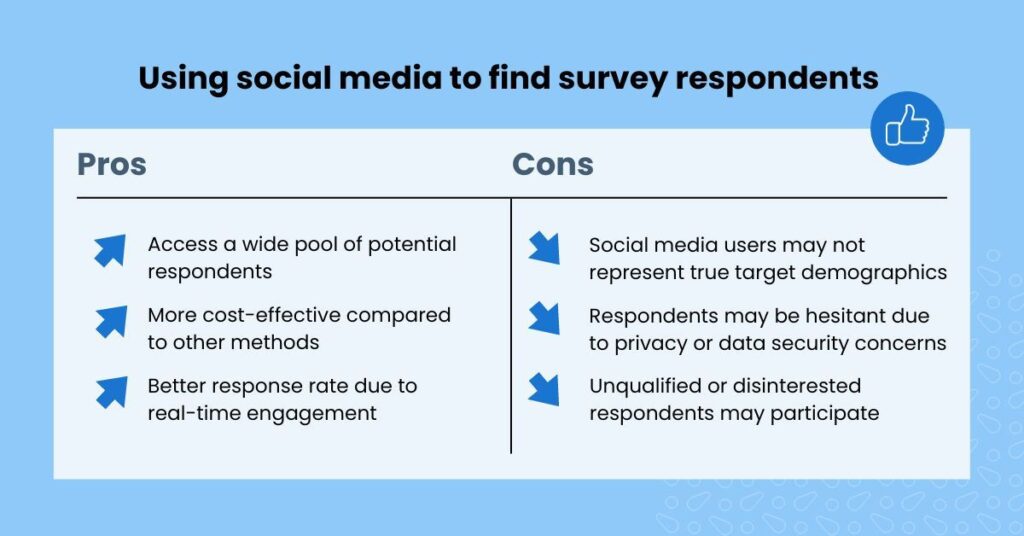
2. Email lists
It’s especially easy to survey your target audience if you already have their email addresses. Use the following steps to create a persuasive customer satisfaction survey invitation email.
Step 1: Write a catchy subject line
Your subject line is one of the most important parts of your email — if it doesn’t grab attention, your customers might delete the email without ever opening it. Use your business name in the subject line and keep the tone conversational and friendly.
Step 2: Create the message
Write a meaningful and personalized message asking your customers to share honest feedback about their recent purchases or interactions with your business. Don’t forget to state that you value their unique feedback and intend to use it to improve your products and services.

Step 3: End with a purposeful CTA
Be sure to add a direct call-to-action (CTA) button at the end of the email so that your customers know exactly what action to take and how to take it.
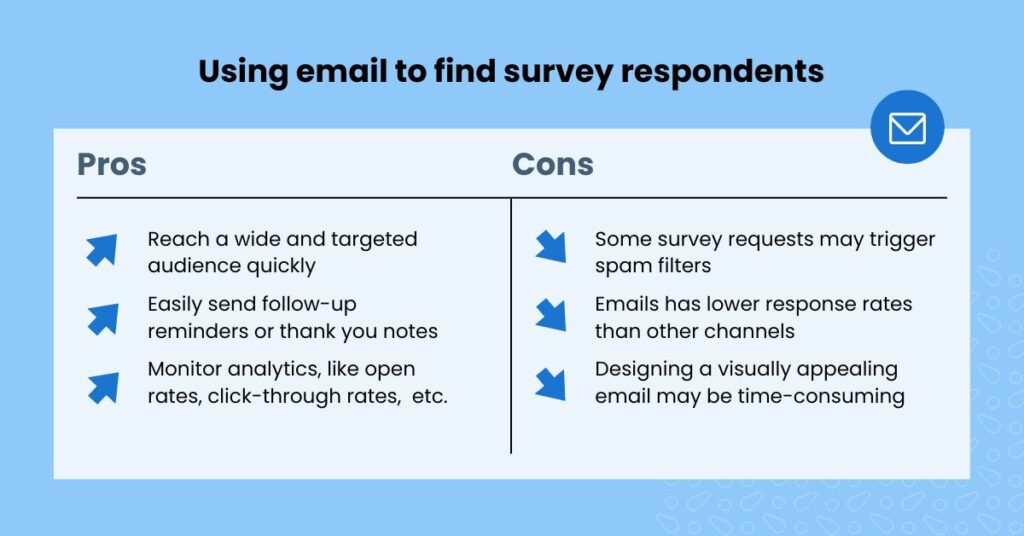
3. Text subscriber lists
If you have a list of phone numbers, text subscriber lists are great for generating respondents. Be mindful to keep your text messages short, direct, and meaningful.
Also, add a survey link to the page where you want your customers to share their feedback. NPS surveys work really well with SMS, too, due to their simplicity.
SMS texting is a more personalized way of communicating with customers. Just be sure that you select the appropriate texting time (not in the middle of the night) for sending out your survey request.
4. Reviews
Look at reviews about your business on Google or Facebook. Choose the most relevant reviews, based on the purpose of your survey. For example, if you’re trying to improve a product, prioritize those specific reviews that give detailed feedback about the product’s features or performance.
Next, reach out to the customer who left the review. Send a personalized message asking them to participate in your survey. Make a point to mention why their feedback is particularly valuable.
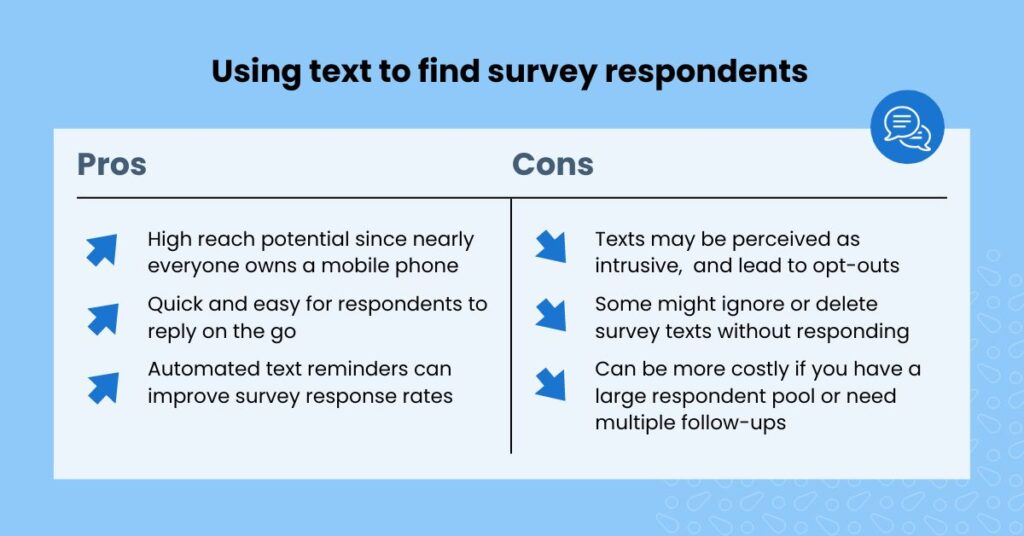
5. In person
You can also get survey respondents physically by interacting with customers who come to the physical location where you do business. Additionally, you can turn to your own loyal employees if they are eligible as relevant respondents to your survey.
Other physical locations where you can find respondents include:
- Malls, parks, public squares, local events
- Playgrounds, schools, public-teacher meetings
- Colleges, libraries, community centers
Always approach potential respondents politely and professionally. If they’re not interested, thank them for their time and move on. Do not pressure anyone into participating.
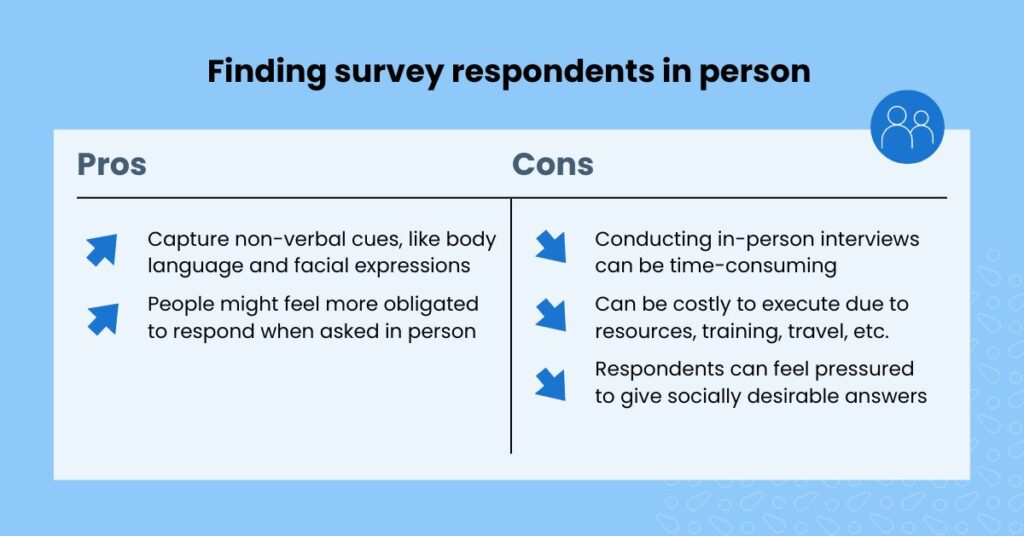
Best practices for keeping survey respondents engaged
Many people may disregard an online survey invitation if it has no clearly defined purpose. A well-designed customer survey will collect honest answers and assist with data collection. It will also increase response rates.
Here are some actionable tips and best practices that will help you get the most out of your survey respondents.
1. Set expectations upfront
Let respondents know upfront just how long the survey will take to complete. If possible, add a progress bar at the bottom of each page, too. This allows them to see how far through the survey they are. It’s also potentially encouraging to keep them going to complete the survey.
2. Keep the survey short
Be respectful of your respondent’s time. Ask short, easy-to-answer, and simple questions that your respondents can understand. Avoid the overuse of jargon, as this can lead to the abandonment of the survey. Lastly, verify that your survey questions flow well in the order you’ve placed them.
3. Make it convenient
Make it easier for customers to participate in the online survey. Include a direct link to the survey questions so respondents don’t have to work hard to find the survey. You can additionally send the survey invitation via text or email.
4. Ask open-ended questions
Open-ended questions give participants a chance to respond in greater detail. Be sure to phrase your questions and research topic correctly to avoid receiving generic one-word, yes-or-no answers.
Survey respondent FAQs
To choose the ideal respondents for your survey, focus on the objectives of the survey research. This ensures that you’re identifying a representative sample of the target population.
When testing a survey, verify that the questions are clear and unbiased to effectively measure the intended variables.
You can identify participants for a survey by checking your research objectives and target demographic. From there, you can draw a sample of your research respondents.
When designing a survey, it is crucial to:
1. Consider the clarity and simplicity of questions to avoid confusion.
2. Ensure that questions are unbiased and neutral to prevent leading responses
3. Survey the right group of people to ensure valid results.
To get more participants in a survey, offer incentives or rewards for participation. In addition, promote the survey widely through social media, email, and partnerships.
Get the most out of your surveys with Birdeye
Get a deeper insight into what customers think about your company or its services with custom surveys. Birdeye survey software lets you ask only the questions that matter the most and to the right audience. Learn how to automate your online survey invitations and get more respondents.

Originally published
